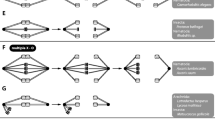Abstract
In a single male specimen of Myrmeleon mexicanum Banks the sex chromosomes, normally X and Y, were replaced by what appeared to be X1X2 and Y. These segregated as expected on that interpretation in only half of the spermatocytes — in the other half, one X and the Y segregated from the other X. This atypical segregation is explicable on the assumption that one of the supposed Xs is a supernumerary, not a sex chromosome, and the diploid complement of the male comprises six pairs of autosomes plus a supernumerary and the X and Y sex chromosomes. The orientation of the X chromosomes at first metaphase was variable: kinetochoric activity may be localized midway the length of the chromosome, as in gonial mitosis, or terminally. Comparative study of three congeneric species, seven of Brachynemurus, one of Psammoleon, and one of Vella showed normal segregation in all, and no evidence for secondary kinetochoric activity. In nine of the species studied one pair of autosomes was unconjoined at first metaphase in 0.3%–1.2% of primary spermatocytes. These autosomes segregated precociously with the sex chromosomes in the central unit of the spindle. In one exceptional male of Brachynemurus hubbardi Currie all first meiotic metaphases showed this behavior, and a compound X1X2/Y1Y2 system was thus simulated. Bivalent formation replaced distance segregation of sex chromosomes in 0.4%–3.2% of the spermatocytes in seven of the thirteen species studied. These sex-bivalents frequently displayed partial or complete failure in congression.
Similar content being viewed by others
References
Hirai H (1955) Notes on the chromosomes of the Osmyloidea (Neuroptera). Misc Rep Yamashita's Inst Ornith Zool 6:269–270
Hughes-Schrader S (1969) Distance segregation and compound sex chromosomes in mantispids (Neuroptera: Mantispidae). Chromosoma 27:101–129
Hughes-Schrader S (1975) Male meiosis in camel-flies (Raphidioptera:Neuropteroidea). Chromosoma 51:99–110
Hughes-Schrader S (1979) Diversity of chromosomal segregational mechanisms in mantispids (Neuroptera:Mantispidae). Chromosoma 75:1–17
Naville A, Beaumont J de (1933) Recherches sur les chromosomes des Névroptères. Arch Anat Microsc 29:199–243
Naville A, Beaumont J de (1936) Recherches sur les chromosomes des Névroptères. Part II. Arch Anat Microsc 32:271–302
Oguma K, Asawa JJ (1932) Additional data to our knowledge on the dragonfly chromosome, with a note on occurrence of X-Y chromosome in the ant-lion (Neuroptera). J Fac Sci Hokkaido Univ Ser VI 1:134–142
Snow R (1963) Alcoholic hydrochloric acid-carmine stain for chromosomes in squash preparations. Stain Technol 38:9–13
Author information
Authors and Affiliations
Rights and permissions
About this article
Cite this article
Hughes-Schrader, S. Chromosomal segregational mechanisms in ant-lions (Myrmeleontidae, Neuroptera). Chromosoma 88, 256–264 (1983). https://doi.org/10.1007/BF00292902
Received:
Revised:
Issue Date:
DOI: https://doi.org/10.1007/BF00292902




